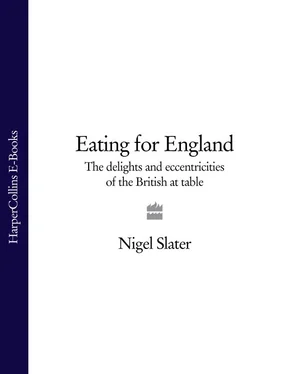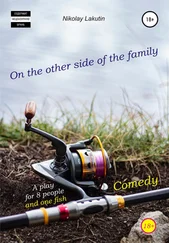Do I tell them about the meltingly tender lamb from North Ronaldsay, the famous apple hat pudding with its tender suet crust, or the northern teacake known as the fat rascal? Do I have time to enthuse about the joys of medlar jelly, damson gin and the unpasteurised cheeses made down long leafy lanes in Dorset, Devon and Dumfries? Perhaps I should wax eloquent about Wiltshire bacon, sherry trifle, Christmas pudding, or steak-and-kidney pie with its crumbly pastry and dark and savoury filling? Will there be time to get in name-checks for Scottish heather honey, toasted teacakes, gooseberry fool and Caerphilly cheese? And will they let me squeeze in the glory that is a decent haggis, Welsh rarebit or Cornish pasty?
Or do I tell them the truth? That for every Brit eating our legendary roast beef and jam roly poly there are a million more tucking into Thai green curry and pepperoni pizza. That more people probably eat chocolate brownies than apple crumble and custard, and that it is now easier to find decent sushi than really good roast beef. Should I mention too that despite our love of all that is local, fresh, organic and ‘real’, we also have a list of edible icons more eccentric than anyone could ever imagine?
It is well known that we have been arguing for years whether gravy should be thick or thin, if pickled onions should be part of a ploughman’s lunch, or whether or not jelly belongs in a trifle. I wonder what they would also make of the fact that different counties argue about whether the jam or the clotted cream goes onto a scone before the other, or that more of us apparently use gravy browning than wine to capture the heavenly pan juices of our Sunday roast.
British food is, of course, about roast beef and Yorkshire pudding; it is about dressed crab, and roast chicken with nutmeggy bread sauce. It is about huge flakes of locally caught fish in crisp batter, eaten from the paper with the sea breeze in your hair, oysters from Whitstable as fresh as an icy wave, Eccles cakes with soft, flaky pastry, and the best bacon sandwich in the world. But it is also about Heinz tomato ketchup, brown sauce and Cadbury’s Fruit and Nut. The biggest names on the high street are not Betty’s tea rooms but Starbucks and Subway. There are more Pizza Expresses than traditional pie and mash cafés, and more McDonald’s than fish-and-chip shops. Looking at some people’s supermarket trolleys (oh, come on, you know you have), I sometimes wonder how you could define this country’s tastes at all. The internet, by the way, gives approximately 375,000 entries for roast beef and Yorkshire pudding, but over five million for that other great British invention, the Mars bar.
The fact of the matter is that our food culture is about both the gentle, buttercup-scented cheese made in a village barn the colour of honey, and the childish delight of unwrapping a foil triangle of Dairylea. It is indeed true that we make the most crumbly and agreeable oatcakes in the world, but it is the mass-produced cream cracker that has become the culinary icon. And despite producing some of the most delectable pork products in the world, we still love tucking into a bacon sandwich from a greasy-spoon café.
We have a greater wealth of good food in this country today than ever before. When I go to the market at the weekend for my cheeses, vegetables and meat, I am spoilt for choice by the food we produce, and often come home with a shopping bag almost too heavy to lift. In that respect I think of myself as being truly attached to the locally-produced, the artisan-crafted and the handmade. So how come I also regard a plain chocolate digestive biscuit as one of the finest things this country has to offer?
The British have a curiously broad culinary identity. Only the naïve would now try to pin us down as a meat-and-two-veg culture. You could argue that ours is a rich and multiculturally exciting cuisine, reflecting a country of diverse tastes and open minds; but equally, it sometimes looks as if we are in a state of total culinary shambles. If we hold up a pot of tea with scones and jam as a national treasure (and I do), then why is it easier to find an Italian cappuccino and an all-American blueberry muffin on most high streets? And how is it that while the French almost called a national strike over any suggestion of using pasteurised milk in their cheeses, the Spanish all but went to war to protect their fishing, and Italy gave its Parmesan cheese internationally protected status, we British only truly went into meltdown over the repackaging of the KitKat? (And quite rightly, if you ask me.)
What the French or the Italians may get excited about is very, very different from what most of us in these islands are likely to hold dear. We hold a candle for everything from black pudding to the Custard Cream, feel more fondness for Murray Mints than for a decent veal chop, and are rather partial to leaving our most famous food for the tourists while we ourselves tuck into something from another culture.
This book is my portrait of this curious, often contrary culture, from our adoration of the kipper, the pork scratching and the Rowntree’s Fruit Gum to our inability to tip properly in restaurants. I feel that while the heroic efforts of our artisan food-makers have been well catalogued (though still far from well enough patronised), all too little attention has been paid to the food that most of us either actually eat, or at least carry a certain lingering affection for. Eating for England is simply a personal celebration of the food this nation cherishes, the rituals we observe, the curious and even eccentric thing that is the British and their food.
Nigel Slater
June 2007
The British make an everyday stew with cubes of beef, carrots, parsnips and onions. They pour a jug of water over it, tuck in a bay leaf and leave it in the oven to do its own thing for four hours. What emerges is grey, meltingly tender meat and gently flavoured broth, comforting and unapologetic in its frugality. It tastes of nothing but itself.
There are formal similarities between our national stew and those of Europe and its neighbours. The knee-jerk shopping list of onions and carrots; the introduction of some sort of benevolent liquid; the convenient habit of leaving the simmering ingredients unattended for an hour or more, are common to all. The southern French recipe will be made with beef rump, its obligatory onions softened in the bright, fruity oil of the region, and its seasonings of orange peel, mauve garlic, sun-scarred tomatoes and, possibly, lavender inevitably breathe sunshine into its soul. Further north, as you potter down the Rhone valley during the vendange in October, your day might be punctuated by a paper-tablecloth lunch of cubed beef that has simmered since breakfast with shallots, strips of unsmoked bacon, rosemary and mushrooms in an inky violet-red wine.
The Italians, though less likely to use alcohol, will add body to the simplest stew of boneless brisket with the introduction of a whole, cheap tongue and a gelatinous, collagen-rich cotechino sausage. The juices that surround the meat may look more like ours than do the mahogany-hued French or the paprika-stained Spanish versions, but will be silkily limpid in the mouth because of the goodness distilled from both tongue and cotechino. If a British stew is rich at all, it will be because of the early addition of flour to the meat, the thickening qualities of which give the impression of suavity but add nothing in terms of flavour.
And then, just as we Brits abandon our stew to the hungry hordes gathered at the table, the cooks of other nations will add a vital snap of freshness and vigour to lift it from its sleepy brown torpor: the French their persillade of vivid parsley, anchovy and lemon; the Moroccans a slick of tongue-tingling harissa the colour of a rusty bucket; and the Italians a pool of hot, salty salsa verde pungent with basil, mustard and mint. The Catalans, who, as history would have it, are unlikely ever to spend a penny more than necessary, will even so stir in a final topping of garlic, breadcrumbs, almonds and bitter chocolate fit for royalty.
Читать дальше











